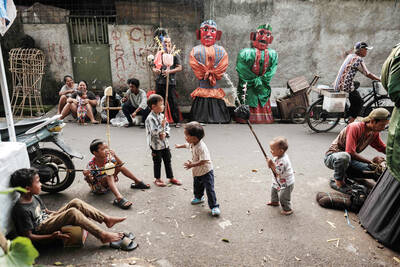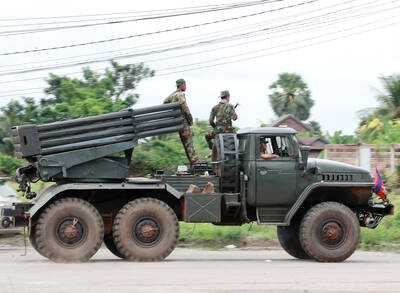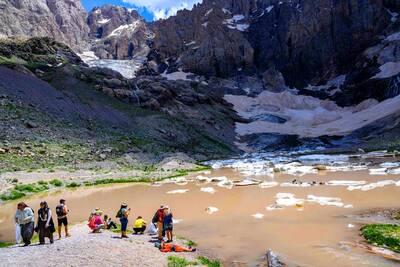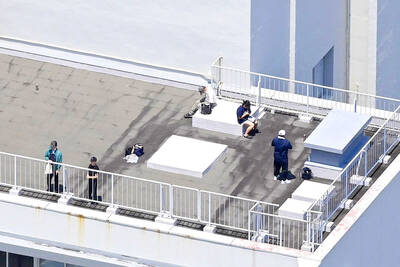China plans to inject nearly US$1.5 billion into a western region where riots killed nearly 200 people last year, boosting its economy in hopes of reducing ethnic tension.
Various regions across Xinjiang, including 82 cities and towns, will receive investment from 19 provinces and municipalities around China over the next year to help improve housing, employment and education opportunities under the plan, the state-owned China Daily newspaper reported yesterday.
The plan aims to increase living standards, build the region into a “moderately well-off society” and maintain long-term stability, the newspaper said, citing a report in Outlook magazine, a publication of Xinhua news agency.
Experts say the plan, if carried out successfully, will aim to quell social unrest in the region.
“Improving Xinjiang’s economy is the only way the government can stabilize the region, not by guns or increased security,” said Hu Zhaoliang, a professor of regional development at Peking University, who has researched the region.
“By helping locals with language barriers and giving them better opportunities, the resentment will slowly wane,” Hu said.
Ethnic tensions in China’s far-western region have simmered since the riots last July, which also wounded nearly 1,600 people.
China’s worst ethnic violence in decades began when Uighurs, a Turkic-speaking minority ethnic group, clashed with police during a protest in the Xinjiang capital of Urumqi.
The Uighurs see Xinjiang as their homeland and resent the Han Chinese who have moved into the region in recent decades. A simmering separatist campaign has occasionally boiled over into violence in the past 20 years.
The government says it has already poured billions of dollars into the area and substantially raised living standards there.
China blames the rioting on overseas-based groups agitating for greater Uighur rights in Xinjiang, but has presented no direct evidence.

In the sweltering streets of Jakarta, buskers carry towering, hollow puppets and pass around a bucket for donations. Now, they fear becoming outlaws. City authorities said they would crack down on use of the sacred ondel-ondel puppets, which can stand as tall as a truck, and they are drafting legislation to remove what they view as a street nuisance. Performances featuring the puppets — originally used by Jakarta’s Betawi people to ward off evil spirits — would be allowed only at set events. The ban could leave many ondel-ondel buskers in Jakarta jobless. “I am confused and anxious. I fear getting raided or even

POLITICAL PATRIARCHS: Recent clashes between Thailand and Cambodia are driven by an escalating feud between rival political families, analysts say The dispute over Thailand and Cambodia’s contested border, which dates back more than a century to disagreements over colonial-era maps, has broken into conflict before. However, the most recent clashes, which erupted on Thursday, have been fueled by another factor: a bitter feud between two powerful political patriarchs. Cambodian Senate President and former prime minister Hun Sen, 72, and former Thai prime minister Thaksin Shinawatra, 76, were once such close friends that they reportedly called one another brothers. Hun Sen has, over the years, supported Thaksin’s family during their long-running power struggle with Thailand’s military. Thaksin and his sister Yingluck stayed

Kemal Ozdemir looked up at the bare peaks of Mount Cilo in Turkey’s Kurdish majority southeast. “There were glaciers 10 years ago,” he recalled under a cloudless sky. A mountain guide for 15 years, Ozdemir then turned toward the torrent carrying dozens of blocks of ice below a slope covered with grass and rocks — a sign of glacier loss being exacerbated by global warming. “You can see that there are quite a few pieces of glacier in the water right now ... the reason why the waterfalls flow lushly actually shows us how fast the ice is melting,” he said.

Residents across Japan’s Pacific coast yesterday rushed to higher ground as tsunami warnings following a massive earthquake off Russia’s far east resurfaced painful memories and lessons from the devastating 2011 earthquake and nuclear disaster. Television banners flashed “TSUNAMI! EVACUATE!” and similar warnings as most broadcasters cut regular programming to issue warnings and evacuation orders, as tsunami waves approached Japan’s shores. “Do not be glued to the screen. Evacuate now,” a news presenter at public broadcaster NHK shouted. The warnings resurfaced memories of the March 11, 2011, earthquake, when more than 15,000 people died after a magnitude 9 tremor triggered a massive tsunami that